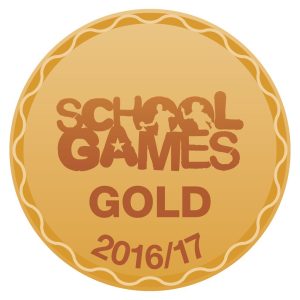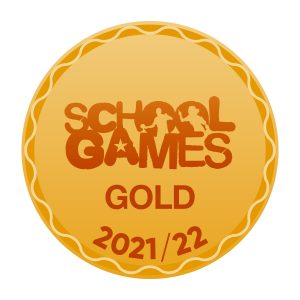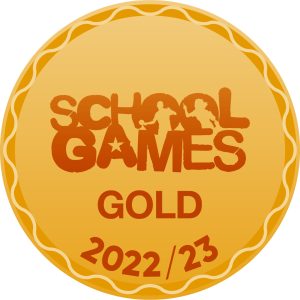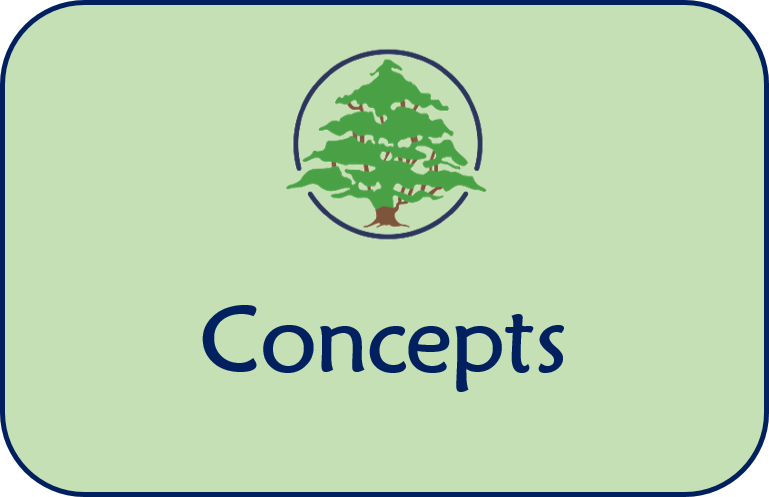Physical Education
Physical Education at Stocksbridge Junior School
At Stocksbridge Junior School, every child is physically literate. Our vision for PE is to give every child the opportunity to engage in high-quality physical education in order to improve their physical, social and mental health and to inspire children to be physically active long term. We have been awarded Centre of Excellence status by Yorkshire Sport and Gold School Games Mark after being recognised for our outstanding physical education provision.
Intent
At Stocksbridge Junior School, we aim to develop the knowledge, skills and understanding necessary for the physical, mental, social and emotional wellbeing of our children, in order to make a positive impact now and for their future. We aim to provide a broad and balanced PE curriculum focussing on the development of the whole person and in doing so, we hope that all children will go on to make positive physical activity choices throughout their lives.
We want all children to experience a range of different physical activities to enable them to develop:
- Fine and gross motor skills
- Confidence
- Fitness levels
- Leadership / refereeing skills
- Creativity
- Problem-solving
- Knowledge of rules and tactics
- Analysis and evaluation skills
In line with the delivery of ‘British Values’ we aspire to teach children how to collaborate and cooperate with others, as part of a team, understanding equality and fair play to embed life-long values.
Implementation
Pupils at Stocksbridge Junior School participate in weekly, high-quality PE and sporting activities, which are timetabled with either specialist PE or classroom teachers, all underpinned by the notion of ‘physical literacy’. PE is further supplemented in all year groups by regular active ‘brain breaks’ to support learning, in addition to Kagan active learning structures evident during all lessons. All pupils from Year 3 to 6 have at least 2 hours’ worth of physical activity each week, including active lunchtimes with our Sports Leaders, using our active ‘Cedarwood’ outdoor playground and access to extracurricular PE provision. Children in Year 4 participate in a minimum of 12 weeks of swimming lessons to enable them to swim competently over a distance of at least 25 metres. Pupils continue to develop their fundamental movement skills such as balance, coordination, agility, running, jumping, throwing and catching and then to apply them to competitive or modified game situations during their PE lessons. Performances using movement patterns are evaluated and feedback is provided on their own and others’ work. Pupils communicate and collaborate with each other and develop an understanding of how to develop their physical competence. There are many opportunities throughout the academic year for children to participate in inter and intra-school competitions, as well as festivals, where children’s successes in sports are celebrated. For example, the annual community fun run and cycling workshops.
At Stocksbridge Junior School, all children are provided with high quality and challenging activities in a range of sports including:
- Basketball
- Athletics/fitness
- Gymnastics
- Football
- Dance
- Netball
- Rounders
- Cricket
- Tag rugby
- Orienteering and outdoor and adventurous activities (OAA)
- Swimming and water safety
Using the national curriculum as a basis, each activity progresses in complexity and knowledge as children move from Year 3 to Year 6. This ensures that skills are developed year by year and sequenced appropriately to maximise learning for all children.
Lessons are broken down into:
- Learning objective/success criteria
- Warm-ups and stretches
- Skills progression and deepening learning
- Applying skills in a competitive situation/performance
- Plenary
Healthy Week
We run a healthy week every year, which gives the opportunity for children to take part in numerous classroom and practical activities including:
- Rowing challenge
- Smoothie bike
- Sports day
- Fencing
- Dance
- Poster competition
- Daily mile
- Health-based classroom tasks
- Healthy food workshops
Competitions
Intra-school
Intra-school competitions occur throughout the year in PE lessons, sports days and in healthy week. In PE lessons, all children compete in modified games and activities to improve their knowledge of rules, develop teamwork and to promote competition. We have four houses that can be used in intra-school competition and form the basis for our sports day:
- Hunshelf
- Ewden
- Broomhead
- Wharncliffe
Inter-school
We take part in many inter-school competitions. Many of the following competitions have up to four rounds.
Round 1: Cluster competition
Round 2: Partnership competition
Round 3: City Finals
Round 4: South Yorkshire Finals.
Competitions include:
- Sportshall athletics – Year 4 and Year 6 competitions.
- Outdoor athletics – Year 5 and Year 6 competitions.
- Hotshots basketball – Year 4 and Year 5 competitions.
- Cross county and orienteering – all years – Saturday competitions.
- Inclusive sport festival – all years.
- Cricket – Year 5 competition.
- Sheffield football league – Year 5 boys / Year 6 boys / Year 5 and 6 girls competitions.
- Futsal – Year 5 girls competition.
- Gymnastics – all years.
- Handball – Year 4 competition.
- Rounders – Year 5 and Y6 competitions.
- Rowing – Year 6 competition.
- Rugby – Year 5/6 competition.
- Swimming Gala – all years.
- Partnership sports day Year 3 – whole year group competition.
- Cluster festivals e.g. benchball competition.
Extracurricular Sport
Children have the opportunity to take part in a number of extracurricular clubs including:
- Gymnastics (all years).
- Lunchtime football coach (all years).
- Basketball (Year 3, 4 and 5).
- Football (Year 3 and 4 football coach / Year 5 and 6 training).
- Active girls Club (all years – targeted).
- Swimming (all years).
- Sportshall athletics (Year 5 and 6).
- Outdoor athletics (Year 5 and 6).
- Mini mermaids (all years – targeted).
- Rounders (Year 5 and 6).
- Cricket (Year 5).
- Cross country and orienteering (all years – Saturdays).
Sports Leaders Lunchtime Club
Fifteen Year 6 sports leaders are selected each year to run lunchtime activities for Year 3 and 4 children (rota) and support school events. These children are trained by the PE department at the beginning of the academic year to develop their leadership skills. Two children who demonstrate outstanding leadership are chosen to take part in the Links Partnerships Leadership day.
Links with local sports clubs
We encourage children to take part in the following clubs through whole school assemblies, competitions, taster sessions and via the PE department:
- Stocksbridge Rugby Club.
- Stocksbridge Cricket Club.
- Nicola Priestly Academy of Dance.
- Stocksbridge Park Steels and Junior Foxes Football Club.
- Phonix Gymnastics Club (Stocksbridge).
- Kickboxing and Karate – Richard Taylor Reactive Fitness.
- Stocksbridge Tennis Club.
- Hallamshire Harriers Running Club.
- Stocksbridge Pentaqua Swimming Club .
- Judo – Gareth Howell.
- Links Coaches e.g. fencing, rowing.
- Stocksbridge Leisure Centre – a variety of activities and coaches.
Physical Education Achievements
Centre of Excellence: We are one of the few schools in Yorkshire who have been recognised for their outstanding Physical Education provision and have become a Centre of Excellence. We are used in a variety of ways to improve Physical Education in other schools in Yorkshire.
School Games Mark Gold: The School Games Mark is a government-led awards scheme launched in 2012 to recognise schools for their commitment to the development of competition across their school and into the community. Participating in this process allows schools to evaluate their PE provision and assists them in developing an action plan for future progress. Stocksbridge Junior School has once again achieved School Games Mark Gold!
|
|
|
|
|
|
|
Impact
At Stocksbridge Junior School, the impact of physical education extends beyond teaching basic fundamental movements, basic sports skills or promoting physical activity. Physical education plays a crucial role in the holistic development of young learners, influencing their physical, mental, social, and emotional well-being.
- Physical health: PE promotes physical fitness and the health of our children. Through a careful selection of activities, pupils develop fundamental movement skills such as running, throwing, jumping and catching, which form the foundation for a physically active lifestyle. Regular participation in PE classes helps combat childhood obesity, enhances cardiovascular health, and strengthens muscles and bones.
- Motor skills development: The PE curriculum focusses on improving motor skills, coordination and agility. By engaging in a variety of sports and activities, pupils refine their fine and gross motor skills, which are essential for performing daily tasks, sports and recreational activities throughout their lives.
- Cognitive development: PE contributes to cognitive development. Activities that require strategy, teamwork and problem-solving skills, such as team sports and cooperative games, stimulate brain function and enhance cognitive abilities.
- Social skills: PE provides opportunities for pupils to interact with their peers in a structured environment. Team-based activities and group work develop valuable skills such as cooperation, communication, leadership and teamwork. They develop empathy, respect for others and sportsmanship.
- Emotional well-being: PE plays a vital role in nurturing pupils’ emotional well-being and mental health. PE classes provide a safe learning environment for children to express themselves, manage emotions, and develop resilience in the face of challenge, fostering a positive attitude towards physical activity and self-confidence.
At Stocksbridge Junior School, we employ effective methods of assessing and tracking pupils’ progress in physical education. This includes:
- Regular formative assessment through observation, questioning, and self-reflection, allowing teachers to provide immediate feedback and support.
- Providing opportunities for pupils to assess their own progress and set personal targets.
- Ensuring all pupils make progress in developing their physical literacy, fundamental movement skills, and sports-specific skills.
- Promoting a positive attitude towards physical activity and a commitment to maintaining a healthy lifestyle beyond school.
- Instilling values of respect, fair play, and perseverance through regular participation in competitive and non-competitive activities.
- Utilising summative assessment to assess pupils’ attainment against age-related expectations.
- Tracking pupils’ participation rates in different activities and their levels of physical fitness over time.
Stocksbridge Junior School Curriculum for Physical Education
The National Curriculum for Physical Education
Purpose of study
A high-quality physical education curriculum inspires all pupils to succeed and excel in competitive sport and other physically demanding activities. It should provide opportunities for pupils to become physically confident in a way which supports their health and fitness. Opportunities to compete in sport and other activities build character and help to embed values such as fairness and respect.
Aims
The national curriculum for physical education aims to ensure that all pupils:
- Develop competence to excel in a broad range of physical activities.
- Are physically active for sustained periods of time.
- Engage in competitive sports and activities.
- Lead healthy, active lives.
Subject content: key stage 2
Pupils should continue to apply and develop a broader range of skills, learning how to use them in different ways and to link them to make actions and sequences of movement. They should enjoy communicating, collaborating and competing with each other. They should develop an understanding of how to improve in different physical activities and sports and learn how to evaluate and recognise their own success.
Pupils should be taught to:
- Use running, jumping, throwing and catching in isolation and in combination.
- Play competitive games, modified where appropriate [for example, badminton, basketball, cricket, football, hockey, netball, rounders and tennis], and apply basic principles suitable for attacking and defending.
- Develop flexibility, strength, technique, control and balance [for example, through athletics and gymnastics].
- Perform dances using a range of movement patterns.
- Take part in outdoor and adventurous activity challenges both individually and within a team.
- Compare their performances with previous ones and demonstrate improvement to achieve their personal best.
Swimming and water safety
All schools must provide swimming instruction either in key stage 1 or key stage 2. (Stocksbridge Junior School provides swimming instruction to children in Year 4.)
In particular, pupils should be taught to:
- Swim competently, confidently and proficiently over a distance of at least 25 metres.
- Use a range of strokes effectively [for example, front crawl, backstroke and breaststroke].
- Perform safe self-rescue in different water-based situations.







